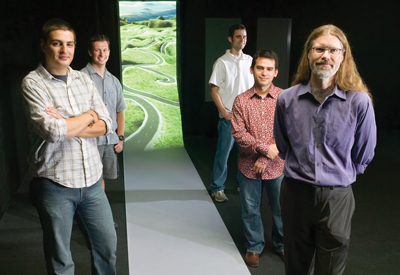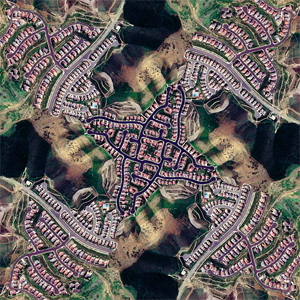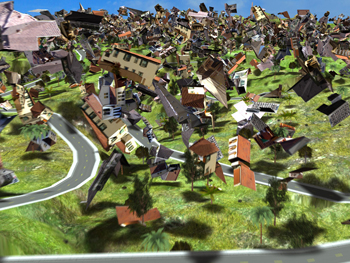UC San Diego Artist?s ?Scalable City? on Exhibit at National Academy of Sciences
Washingon D.C. and San Diego, CA, June 4, 2007 -- After Los Angeles, Warsaw, Linz, and Shanghai, Washington D.C. is the newest venue for an interactive multimedia art installation developed by University of California, San Diego visual arts professor Sheldon Brown. Components of his Scalable City project went on display today at the headquarters of the National Academy of Sciences in the nation's capital, as part of a new exhibition titled "Speculative Data and the Creative Imaginary: Shared Visions Between Art and Technology."
|
The National Academies exhibition will be on view through Aug. 24, and is organized in conjunction with the Association for Computing Machinery's Creativity and Cognition Conference, to be held in Washington June 13-15.
The exhibition features interactive computer installations, large-format digital prints, and wearable technology, representing a confluence of research and creative practices that include the visual arts, design, architecture, performance, science, technology, and engineering. These works illustrate methods of creative inquiry and practice that have the potential to lead to new forms of knowledge.
UC San Diego's Brown is one of 15 artists selected to show their work in the exhibition. He is the director of UCSD's Center for Research in Computing and the Arts (CRCA) and is the inaugural Artist-in-Residence in the UCSD Division of the California Institute for Telecommunications and Information Technology (Calit2). His Scalable City project is based in the Experimental Game Lab, a partnership of CRCA and Calit2 based in Atkinson Hall on UCSD's La Jolla campus.
|
"Exhibiting this work furthers the conversation across cultural domains about how knowledge is produced and meaning created," said Brown. "The reconciliation of art, science and technology is a necessity for the complexity of our techno-cultural times, and this exhibition is a significant step towards this end."
A full-scale version of Scalable City is part of an ongoing exhibition at Ars Electronica in Linz, Austria, and Brown recently opened a companion exhibit at the Museum of Contemporary Art in Shanghai, China. Earlier incarnations of the work were shown in Zacheta National Gallery in Warsaw, Poland, and at the Electronic Entertainment Exhibition (E3) in Los Angeles, in 2005.
The project is modular, and each version is tailored to the exhibit space. At the National Academy of Sciences, Scalable City consists of a single-screen interactive game environment and a series of large-scale prints on paper and canvas. "The prints come from different stages of the data visualization pipeline, which creates the interactive environment," explained Brown.
|
The exhibition focuses on computer-mediated experiences, technology development, aesthetic practices, and cultural criticality. The works celebrate imaginary scenarios and real-time phenomena from outer space to cyberspace, collective space to urban space, public space to embodied space, and ecological space to dialogical space.
The National Academies exhibition is curated by Pamela Jennings, assistant professor of art and human-computer interaction at Carnegie Mellon University. Apart from curator Jennings and UCSD's Brown, other exhibiting artists include: MIT's Nell Breyer; Donna Cox of the National Center for Supercomputing Applications at the University of Illinois at Urbana-Champaign; Carnegie Mellon's Roger Dannenberg; Tiffany Holmes from the Art Institute of Chicago; UC Santa Barbara's George Legrady and Marcos Novak; Sabrina Raaf from the University of Illinois at Chicago; Bill Seaman from the Rhode Island School of Design; Martin Wattenberg from IBM Watson; and international artists, including Australia's Ernest Edmonds, Canada's Greg Judelman (Banff Center for the Arts) and Thecla Schiphorst (Simon Fraser University), as well as Christa Sommerer and Laurent Mignonneau from the University of Art and Design in Linz, Austria..
Note to reporters: Print-quality images of Scalable City are available at www.sheldon-brown.net/scalable/prints.html .
Related Links
Scalable City http://www.sheldon-brown.net/scalable/
National Academies http://www.nationalacademies.org
National Academy of Sciences http://www.nasonline.org
Media Contacts
Media Contact: Doug Ramsey, 858-822-5825, dramsey@ucsd.edu; Alana Quinn, NAS, 202-334-2415 aquinn@nas.edu



